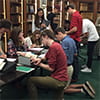The librarians and archivists at Burns Library have been actively working to strengthen teaching support with special collections. From greater participation in instruction training, to purchasing modular tables, to implementing a flipped classroom strategy, Burns Library has invested time and resources in developing an instructional program that supports the needs of BC faculty. Burns staff members reach out to faculty to create new sessions (or improve returning classes) to encourage wider use of Burns materials for teaching and research.
Recent classes at Burns have included undergraduate and graduate students, ranged from 3 to 30 students, and hosted 3 Out of Classroom Experiences. After initial consults with faculty, Burns staff spend significant time customizing classes and selecting topic appropriate materials. To maximize class time, we have developed pre-class presentations to direct students to the Burns classrooms and set expectations about working with rare materials.
In Fall 2017, Burns Library has added content to support Maia McAleavey’s literature courses; combed the holdings to help Steven Pieragastini’s upper-level students studying China become familiar with the usefulness of Western-language sources; introduced Irish Literary revival materials that could be used for a later assignment for Marjorie Howes; demonstrated how documents, letters, and photographs can enhance Senior Seminar research projects assigned by Rob Savage; and selected materials related to witches, vampires, and werewolves to help Jason Cavallari’s first year students learn how to interpret sources for themselves.
Faculty interested in using special collections materials to enhance the learning outcomes of their courses should inquire as early as possible. While there are limitations—capacity, space, and available hours—we are willing to creatively work with faculty to develop sessions and help design activities and assignments that require students to apply and demonstrate what they have learned.
As we move away from the perception of Burns as a museum toward a greater understanding of the research potential available in our special collections, we have experimented with several active learning designs. Successful sessions have included peer learning with primary sources; approaching the book as an artifact; learning the primary source research process in 50 minutes; pairing primary sources with potential research topics; reading visual images in context; and building analytical skills through context and juxtaposition. We look forward to incorporating other active approaches, such as teaching archival literacy through finding aids, demonstrating special collections discovery tools, evaluating digitized primary sources, and more.
Student feedback has indicated that many do not know about Burns Library or that they are welcome to use the collections:
- [I learned] All about the amazing resources available through Burns! I didn’t know that any of this was here.
- Burns doesn’t exist to protect rare texts, but to share them and provide resources for all the students.
Once they are exposed to the materials through interactive instructional sessions, students start to connect the dots:
- I enjoyed the hands-on activity of being able to look at different artifacts in the collections and thinking of what kinds of research it could support.
- It was lovely to look at primary sources pertaining to the period we’re studying as it gives some valuable context.
And then some are converted and want everyone to have the experience:
- How come they do not make us use this more often for projects/papers?
- Maybe you could work with professors … that have more underclassmen so they can benefit from the resources here.
If you are curious about Burns Library holdings and if/how they can enhance your courses, please contact Katherine Fox, Head of Public Services, at katherine.fox@bc.edu or 2-3136. We are already booking and planning Spring 2017 classes and beyond, and look forward to working with you.
